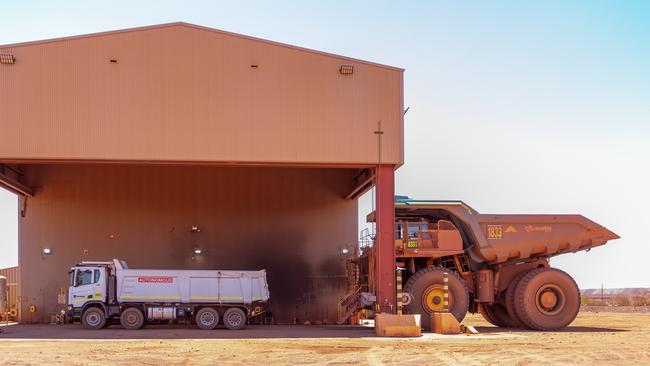Thinking small could revolutionise the way Rio Tinto runs its giant Pilbara mines
Giant trucks hauling Pilbara iron ore have become an iconic symbol of Australia’s mining sector, but Rio Tinto is plotting a quiet revolution that may change that.

At its Channar mine in the Pilbara, Rio Tinto is plotting a quiet revolution in the way it designs and runs the giant iron ore operations that have underpinned its financial success for the last 20 years.
For decades the received wisdom in bulk mining has been that bigger is better. Until the mid-1990s the biggest haul trucks deployed on giant Pilbara mines could carry a payload of about 220 tonnes.
These days majors such as Caterpillar, Komatsu and Liebherr all sell machines capable of moving as much as 400 tonnes of dirt in a single load, and 2013 Belarusian truck maker BelAZ launched sales of a monster hauler it says is capable of shifting close to 500 tonnes of material at a time.
But at Channar Rio is running trials aimed at reversing that thinking, piloting a test pit at the giant iron ore mine that uses 40 tonne driverless civil trucks to move its ore.
Rio began the trials in April with Swedish truck and bus manufacturer Scania, and on Friday the two companies announced they were extending the partnership, after successfully hitting the first major milestones for the autonomous systems.
The rush for size in the mining industry has been all about efficiency – bigger payloads mean less trips up and down a decline, moving more material in less time, and – in theory – at lower costs.
But Rio thinks the Scania trucks – almost toy-sized compared to the behemoths that currently ply its Pilbara haul roads – can deliver ore to its processing plants more cheaply than big rigs, and help the company extend the life of its Pilbara operations, as well as improving the quality of its exports.
But to do that requires not just a changeout of haul fleets, it could lead to a revolution in the way Rio’s mines are designed and operated.
While the Scania trucks won’t move ore as quickly as their giant cousins, Rio’s group technical managing director Santi Pal said on Friday they could help the company mine its ore more selectively – taking out less waste ore per tonne, increasing grades through Rio’s processing plants, and reducing the overall size of the mine’s footprint.
Small trucks mean smaller haul roads, making it easier for Rio to mine around the Indigenous heritage sites that sit inside its Pilbara operations, and could reduce its overall emissions – not to mention that mines built around smaller trucks will make it far easier for the company to convert its fleet to battery-operated electric vehicles, as Rio looks to make good on its promise to stop buying new diesel-powered trucks by 2030.
But Rio also insists that environmental and heritage factors are not the only driver of the trials, suggesting smaller trucks could help lower its overall mining costs, both in the Pilbara and across other parts of its global mining operations.
Small haul roads would also allow Rio to run its Pilbara mines steeper and deeper, helping the company access more ore from ageing deposits.
Rio was careful to note on Friday that not all of its mines will be suitable for the small truck deployment. And a full scale switch would require the complete redesign of future mines from first principles.
But the company has said early results from its trials suggest iron ore recovery at the Channar trial pit could be improved 3 per cent over existing mining methods, along with what is likely to be the big ticket item to reduce costs, a 10 per cent reduction in the ratio of waste rock moved compared to saleable ore.
Rio has also said the trials suggest unit capital costs for the “agile” fleet could be 10 to 25 per cent below levels at comparable mines, and allow the faster and more flexible development of new mines, allowing Rio to bring new operations into the market quicker and more cheaply.
Even if the trials work out the biggest of haul trucks will probably still have a role in the sector, though, if only at the start of a mine when companies need to move vast amounts of waste rock to access valuable ore.


To join the conversation, please log in. Don't have an account? Register
Join the conversation, you are commenting as Logout